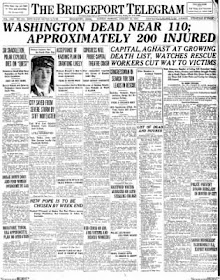 |
 |
 |
Under the weight of snow from a blizzard, the roof of the Knickerbocker Theatre in Washington collapsed on Jan. 28, 1922 - killing 98 people.
More than 100 others were injured at the building at 18th Street and Columbia Road in the Adams Morgan section of the city.
Snow plied high from the two-day storm - subsequently dubbed the "Knickerbocker Blizzard" - delayed fire engines.
Hundreds of soldiers and Marines augmented firefighters and police officers in the rescue effort, and Walter Reed Army Hospital sent ambulances.
A dispatch published in The Bridgeport Telegram, a newspaper in Connecticut, reported:
More than 100 others were injured at the building at 18th Street and Columbia Road in the Adams Morgan section of the city.
Snow plied high from the two-day storm - subsequently dubbed the "Knickerbocker Blizzard" - delayed fire engines.
Hundreds of soldiers and Marines augmented firefighters and police officers in the rescue effort, and Walter Reed Army Hospital sent ambulances.
A dispatch published in The Bridgeport Telegram, a newspaper in Connecticut, reported:
"Firemen worked all night with their picks and shovels. Despairingly they endeavored to remove the concrete of the inner shell of the ceiling roof and walls that had crumbled so suddenly beneath the thousands of pounds of the snow that buried the streets and roofs of the city.
"Soldiers from Fort Myers were detailed with [illegible] torches to cut through the twisted mass of steel and aid in the rescue.
"Inside the buckles walls of the theatre, the early arriving rescuers reported that they were unable to see a single member of the audience when work began. The ceiling had literally engulfed the crowd, variously estimated at between 800 and 1,500 persons.
"The widespread balcony, extending over nearly half of the lower floor of the ill-fated auditorium was sheared away as though by the scythe of death.
"Those who were seated in the balcony were partly protected by the fact that the debris was most under them rather than over them. Peculiarly enough, although the walls are bulged outward, not a window was broken in the theatre.
"The blanket of tragedy, white with the heaviest snowfall in the city’s record since the late ‘60’s, had all fallen straight down.
"The widespread balcony, extending over nearly half of the lower floor of the ill-fated auditorium was sheared away as though by the scythe of death.
"Those who were seated in the balcony were partly protected by the fact that the debris was most under them rather than over them. Peculiarly enough, although the walls are bulged outward, not a window was broken in the theatre.
"The blanket of tragedy, white with the heaviest snowfall in the city’s record since the late ‘60’s, had all fallen straight down.
"Bassett Prudigan, a volunteer rescue worker, late this afternoon uncovered a man who sat bolt upright in his seat. The debris had formed an arch over him. There were no marks on this man to indicate injury. He was dead. His eyes were open.
"His whole appearance was indicative of the fact that he had been gazing at the picture that began the performance and that the shock had killed him."
The newspaper also reported:
"Among the leaders in the work of rescue amid the ruins of the Knickerbocker theatre throughout the night was Representative Alben W. Barkley, Democrat, of the first Kentucky district.
"His whole appearance was indicative of the fact that he had been gazing at the picture that began the performance and that the shock had killed him."
The newspaper also reported:
"Among the leaders in the work of rescue amid the ruins of the Knickerbocker theatre throughout the night was Representative Alben W. Barkley, Democrat, of the first Kentucky district.
"Those about him, striving frantically to dig through tons of re-enforced concrete, broken steel girders and piles of snow, while piteous cries and shrieks for help came from those pinned beneath the debris, saw in their tall, heavy-set co-worker only a calm deliberate fearless leader.
"They knew not that down in his heart he strove to keep back a conviction born of fear that the next body reached every time would be that of his own fifteen-year-old son, Murrell.
"In the street outside, hysterical, praying, Mrs. Barkley waited – with what emotions only a mother can understand.
"Young Murrell had left for the theatre only half an hour before the roof caved in."


